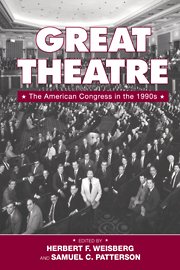12 - “The Play's the Thing”: Congress and the Future
Published online by Cambridge University Press: 20 January 2010
Summary
Congress is, indeed, great theatre. We have sought to analyze how Congress performs as a representative and law-making institution. In this chapter, we aim to bring together the findings of our inquiry. Then, we want to consider congressional change and speculate about the future development of the institution. We know that institutions change, and we are aware that the scholar's understanding of institutional change is incomplete. The 104th Congress, with its new majority party and changed House and Senate leaderships, pressed against the edges of institutional change, demonstrating possibilities. The electoral verdict of the 1996 election foreshadows further interesting development of Congress as it crosses the proverbial bridge to the twenty-first century.
A CONFIRMING ELECTION
We have focused on the drama of change in Congress in the 1990s, but that drama continues. The chapters of this book have described the Congresses up through the 104th, but inevitably, these Congresses were just a prelude to the 105th. It was on November 5, 1996, that the public went to the polls to choose the cast of players for that new Congress. The election proved to be a “confirming election,” with the public reelecting both a Democratic president and a Republican Congress.
The Elections of the 1990s
It is easier to understand the most recent national election if we view it as part of a sequence of elections. Held every second year, congressional elections supply us with a steady record of electoral trends and fluctuations. The four elections preceding 1996 provide this kind of sequence, and we portray the outcomes in Table 12.1.
- Type
- Chapter
- Information
- Great TheatreThe American Congress in the 1990s, pp. 271 - 290Publisher: Cambridge University PressPrint publication year: 1998

